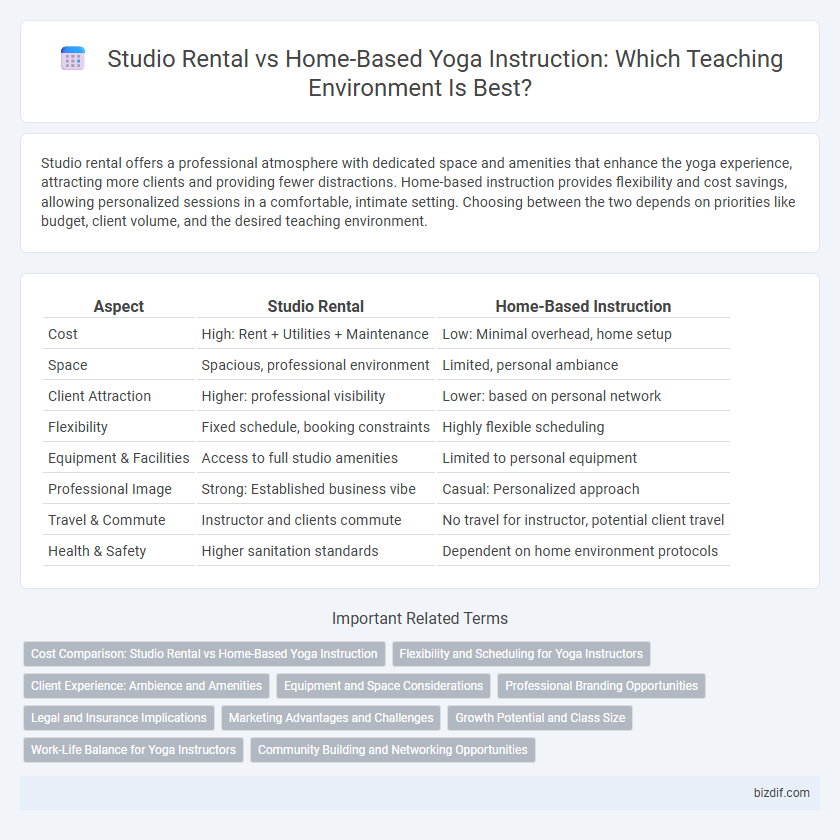Studio rental offers a professional atmosphere with dedicated space and amenities that enhance the yoga experience, attracting more clients and providing fewer distractions. Home-based instruction provides flexibility and cost savings, allowing personalized sessions in a comfortable, intimate setting. Choosing between the two depends on priorities like budget, client volume, and the desired teaching environment.
Table of Comparison
| Aspect | Studio Rental | Home-Based Instruction |
|---|---|---|
| Cost | High: Rent + Utilities + Maintenance | Low: Minimal overhead, home setup |
| Space | Spacious, professional environment | Limited, personal ambiance |
| Client Attraction | Higher: professional visibility | Lower: based on personal network |
| Flexibility | Fixed schedule, booking constraints | Highly flexible scheduling |
| Equipment & Facilities | Access to full studio amenities | Limited to personal equipment |
| Professional Image | Strong: Established business vibe | Casual: Personalized approach |
| Travel & Commute | Instructor and clients commute | No travel for instructor, potential client travel |
| Health & Safety | Higher sanitation standards | Dependent on home environment protocols |
Cost Comparison: Studio Rental vs Home-Based Yoga Instruction
Studio rental for yoga instruction involves fixed costs such as hourly fees ranging from $20 to $50, utilities, and maintenance, which can significantly reduce profit margins for instructors. Home-based yoga instruction eliminates rental expenses, allowing instructors to retain full revenue but may require investment in creating a dedicated, distraction-free practice space. Evaluating these costs, home-based instruction offers higher profitability, whereas studio rental provides professional ambiance and additional amenities at a higher operational cost.
Flexibility and Scheduling for Yoga Instructors
Studio rental offers dedicated space with set hours, providing structured scheduling but limited flexibility due to fixed booking times. Home-based instruction allows yoga instructors to tailor sessions around personal availability and client needs, enhancing flexibility but requiring self-discipline for consistent time management. Balancing structured studio environments with home-based adaptability impacts an instructor's ability to maintain a reliable yet flexible schedule.
Client Experience: Ambience and Amenities
Studio rental offers a professional ambience with dedicated yoga spaces, specialized equipment, and amenities such as showers and lockers, enhancing the overall client experience. Home-based instruction provides a personalized and intimate atmosphere tailored to individual preferences but may lack the advanced facilities and dedicated environment found in studios. Clients seeking a holistic and distraction-free session often prefer the consistency and resources available in studio settings.
Equipment and Space Considerations
Studio rental offers access to professional-grade equipment such as yoga mats, blocks, straps, and sound systems, enhancing class quality and student experience. Dedicated spaces in studios provide ample room for group sessions and specialized setups like heated rooms for hot yoga, which are difficult to replicate at home. Home-based instruction may require significant initial investment to create a safe and comfortable environment, with space limitations impacting class size and movement freedom.
Professional Branding Opportunities
Studio rental provides a professional environment that enhances brand credibility and attracts a diverse client base with specialized amenities and a curated atmosphere. Home-based instruction offers personalized experiences but limits visibility, making it harder to establish a distinct professional identity. Utilizing a studio space enables yoga instructors to leverage marketing opportunities and networking events that significantly boost their brand recognition.
Legal and Insurance Implications
Studio rental for yoga instruction typically requires compliance with commercial lease agreements and often mandates liability insurance coverage specific to the premises, ensuring protection against potential client injuries on-site. Home-based instruction may simplify lease concerns but introduces personal property risks and may necessitate specialized home business insurance to cover client-related incidents and professional liability. Both options demand clear understanding of local zoning laws, professional liability insurance, and risk management policies to mitigate legal exposure and safeguard the instructor's assets.
Marketing Advantages and Challenges
Studio rental offers a professional ambiance and access to established clientele, enhancing brand visibility and trust in yoga instruction marketing. Home-based instruction provides cost savings and personalized environments, appealing to niche markets, but faces challenges in attracting new students due to limited exposure. Effective marketing strategies for studios leverage location and community presence, while home-based instructors rely heavily on digital marketing and social media to build their audience.
Growth Potential and Class Size
Studio rental offers a higher growth potential due to a dedicated space that can accommodate larger class sizes, attracting more students and enabling diverse class formats. Home-based instruction limits capacity, often restricting classes to smaller groups that reduce scalability and revenue opportunities. Choosing a studio environment enhances professional presence and supports sustainable business expansion in the competitive yoga instruction market.
Work-Life Balance for Yoga Instructors
Studio rental offers yoga instructors a dedicated professional space, minimizing distractions and fostering a focused teaching environment which can enhance work-life balance. Home-based instruction provides flexibility in scheduling and reduces commute time, allowing instructors to better manage personal commitments alongside professional duties. Balancing these options depends on individual preferences for boundary-setting and the need for separation between work and personal life in yoga teaching careers.
Community Building and Networking Opportunities
Studio rental offers a dedicated space that fosters community building through group classes and workshops, enhancing networking opportunities among practitioners and instructors. Home-based instruction provides a personalized environment but may limit social interaction and broader community engagement crucial for expanding professional connections. Choosing a studio supports consistent face-to-face engagement, promoting stronger relationships and collaborative growth within the yoga community.
Studio rental vs Home-based instruction Infographic

 bizdif.com
bizdif.com